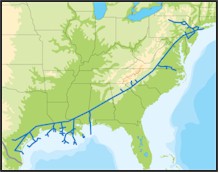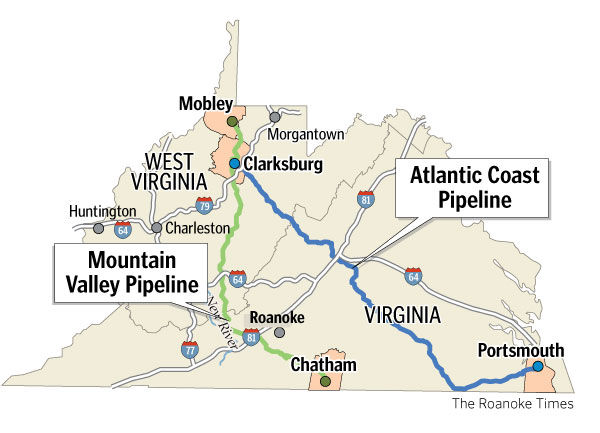Look at the pipelines:
Environmental Assessment for the Leidy Southeast Expansion Project (CP13-551)
Issued August 11, 2014 : http://www.ferc.gov/industries/gas/enviro/eis/2014/08-11-14-ea.asp

Leidy Southeast Expansion Project Environmental Assessment
M&R Stations
Columbia Gas of Virginia - AltaVista M&R Station Pittsylvania County, VA <0.1 <0.1 0.1 0.0 0.0 0.0 0.1 <0.1
Pittsylvania, VA Central Virginia Intrastate (81.143) CO, NO2, O3, Pb, PM10, PM2.5, SO2 nonePittsylvania, VA 0.3 2.4 0.2 / 0.2 0.2 4.8
Pittsylvania, VA Central Virginia Intrastate (81.143) CO, NO2, O3, Pb, PM10, PM2.5, SO2 nonePittsylvania, VA 0.3 2.4 0.2 / 0.2 0.2 4.8
165 Pittsylvania, VA Mainline 1413.0 Install deodorization facilities that filter odorant from gas streamprior to any planned release.
Pipeline company moves to initiate federal review of proposal
By Duncan Adams duncan.adams@roanoke.com 981-3324 | Posted: Tuesday, October 28, 2014 8:00 pm
As envisioned, the $3 billion-plus pipeline project, a joint venture of EQT Corp. and NextEra Energy, would pump natural gas at high pressure through a 42-inch diameter pipe from northwestern West Virginia to southern Virginia. Mountain Valley had previously said the pipeline would be either 36 inches in diameter or 42 inches, but the larger diameter was specified in Monday’s FERC filing.
The proposed pipeline route would take it through 16 counties, including five in Virginia: Giles, Montgomery, Roanoke, Franklin and Pittsylvania.
On Monday, Mountain Valley asked FERC to initiate the agency’s pre-filing process. Tamara Young-Allen, a spokeswoman for FERC, said the process is designed to engage stakeholders, including landowners as well as local, state and federal agencies, to “identify and resolve issues before the formal filing of an application with the commission.”
Mountain Valley, which would need FERC approval to proceed to construction, said it plans to file a formal application sometime in late October or early November 2015. The company reported plans to begin construction in January 2017 and bring the pipeline into service in December 2018.
FERC has assigned a docket number — PF15-3 — for Mountain Valley’s submission and related documents. The docket number provides online access to the pipeline’s filings at FERC.gov and an opportunity to comment on and follow project filings at www.ferc.gov/docs-filing/ferconline.asp.
As of Tuesday, comments filed included three letters expressing opposition to the pipeline. The authors live in Giles County, Blacksburg and Roanoke County. They cited a host of concerns, ranging from groundwater contamination and other environmental damage to fears about pipeline safety hazards and impact on property values.
Natalie Cox, a spokeswoman for EQT Corp., said Tuesday that as of Oct. 24, Mountain Valley Pipeline had contacted a total of 1,725 landowners, including 700 in Virginia, to seek permission to access their land to consider it for the pipeline route.
In an email, Cox reported, “We have received authorization to survey property from approximately 80 percent of landowners on the proposed route.” About 10 percent have denied permission, she said. The remaining 10 percent includes landowners earmarked for follow-up contact, Cox said.
She said Mountain Valley envisions holding open houses in December and January in counties along the pipeline route to discuss the project and address concerns. FERC staff will participate in these events as part of the pre-filing process.
The pipeline would transport natural gas extracted through hydraulic fracturing, or fracking, from Marcellus and Utica shale formations in northern West Virginia, southwestern Pennsylvania and Ohio. The delivery point would be a compressor station for the Transcontinental transmission pipeline in Pittsylvania County.
EQT Corp. and NextEra Energy have said the Mountain Valley Pipeline will meet demand for natural gas in the mid-Atlantic and Southeast regions of the United States.
The joint venture has not denied that some of the natural gas might end up being exported.
“Our primary goal is to deliver gas from the Marcellus and Utica [shales] to communities along the proposed Mountain Valley Pipeline route,” Cox said in an email.
“However, it would be disingenuous for us to say that we have control over what happens with the gas once it reaches Transco Station 165 in Chatham, Virginia,” she wrote.
vz-pipelines-100814
Mountain Valley Pipeline LLC asked the Federal Energy Regulatory Commission on Monday to begin its informal review of the company’s proposed 300-mile interstate natural gas transmission pipeline.
As envisioned, the $3 billion-plus pipeline project, a joint venture of EQT Corp. and NextEra Energy, would pump natural gas at high pressure through a 42-inch diameter pipe from northwestern West Virginia to southern Virginia. Mountain Valley had previously said the pipeline would be either 36 inches in diameter or 42 inches, but the larger diameter was specified in Monday’s FERC filing.
The proposed pipeline route would take it through 16 counties, including five in Virginia: Giles, Montgomery, Roanoke, Franklin and Pittsylvania.
On Monday, Mountain Valley asked FERC to initiate the agency’s pre-filing process. Tamara Young-Allen, a spokeswoman for FERC, said the process is designed to engage stakeholders, including landowners as well as local, state and federal agencies, to “identify and resolve issues before the formal filing of an application with the commission.”
Mountain Valley, which would need FERC approval to proceed to construction, said it plans to file a formal application sometime in late October or early November 2015. The company reported plans to begin construction in January 2017 and bring the pipeline into service in December 2018.
FERC has assigned a docket number — PF15-3 — for Mountain Valley’s submission and related documents. The docket number provides online access to the pipeline’s filings at FERC.gov and an opportunity to comment on and follow project filings at www.ferc.gov/docs-filing/ferconline.asp.
As of Tuesday, comments filed included three letters expressing opposition to the pipeline. The authors live in Giles County, Blacksburg and Roanoke County. They cited a host of concerns, ranging from groundwater contamination and other environmental damage to fears about pipeline safety hazards and impact on property values.
Natalie Cox, a spokeswoman for EQT Corp., said Tuesday that as of Oct. 24, Mountain Valley Pipeline had contacted a total of 1,725 landowners, including 700 in Virginia, to seek permission to access their land to consider it for the pipeline route.
In an email, Cox reported, “We have received authorization to survey property from approximately 80 percent of landowners on the proposed route.” About 10 percent have denied permission, she said. The remaining 10 percent includes landowners earmarked for follow-up contact, Cox said.
She said Mountain Valley envisions holding open houses in December and January in counties along the pipeline route to discuss the project and address concerns. FERC staff will participate in these events as part of the pre-filing process.
The pipeline would transport natural gas extracted through hydraulic fracturing, or fracking, from Marcellus and Utica shale formations in northern West Virginia, southwestern Pennsylvania and Ohio. The delivery point would be a compressor station for the Transcontinental transmission pipeline in Pittsylvania County.
EQT Corp. and NextEra Energy have said the Mountain Valley Pipeline will meet demand for natural gas in the mid-Atlantic and Southeast regions of the United States.
The joint venture has not denied that some of the natural gas might end up being exported.
“Our primary goal is to deliver gas from the Marcellus and Utica [shales] to communities along the proposed Mountain Valley Pipeline route,” Cox said in an email.
“However, it would be disingenuous for us to say that we have control over what happens with the gas once it reaches Transco Station 165 in Chatham, Virginia,” she wrote.





